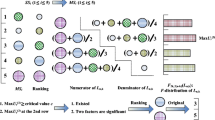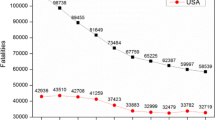Abstract
This paper demonstrates the application of factor screening to multivariable crashworthiness design of the vehicle body subjected to the side impact loading. Crashworthiness, influenced unequally by disparate factors such as the structural dimensions and material parameters, represents a natural benchmark criterion to judge the passive safety quality of the automobile design. In order to single out the active factors which pose a profound influence on the crashworthiness of vehicle bodies subjected to the side impact loading, the unreplicated saturated factorial design is adopted to tackle the obstacle from the factor screening due to its huge benefits in the efficiency and accuracy. In this paper, two different kinds of vehicles are analyzed by the unreplicated saturated factorial design for multivariable crashworthiness and the optimization results enhance the crashworthiness of vehicle. This method overcomes the limitations of design variables selection which depends on experience, and solves the in-efficiency problems caused by the direct optimization design without the selection of variables. It will shorten the design cycles, decrease the development costs and will have a certain reference value for the improvement of the vehicle’s crashworthiness performance.



















Similar content being viewed by others
References
Chen Y, Kunert J (2004) A new quantitative method for analyzing unreplicated factorial designs. Biom J 46:125–140
Craig KJ, Stander N, Dooge DA, Varadappa S (2004) Automotive crashworthiness design using response surface-based variable screening and optimization. Eng Comput 22(1):38–61
Daniel C (1976) Applications of statistics to industrial experimentation. Wiley, New York
Deb K, Pratap A, Agarwal S, Meyarivan T (2002) A fast and elitist multi-objective genetic algorithm: NSGA-II. IEEE Trans Evol Comput 6(2):182–197
Dong F (1993) On the identification of active contrasts in unreplicated fractional factorials. Stat Sin 3(1):209–217
Economic Commission for Europe (ECE) (2003) Regulation No. 95, uniform provisions concerning the approval of vehicles with regard to the protection of the occupants in the event of a lateral collision, October
Forsberg J, Nilsson L (2006) Evaluation of response surface methodologies used in crashworthiness optimization. Int J Impact Eng 32:759–777
Hou SJ, Li Q, Long SY, Yang XJ, Li W (2007) Design optimization of regular hexagonal thin-walled columns with crashworthiness criteria. Finite Elem Anal Des 43:555–565
Hou SJ, Li Q, Long SY, Yang XJ, Li W (2008) Multiobjective optimization of multi-cell sections for the crashworthiness design. Int J Impact Eng 35:1355–1367
Hou SJ, Li Q, Long SY, Yang XJ, Li W (2009) Crashworthiness design for foam filled thin-wall structures. Mater Des 30:2024–2032
Hou SJ, Han X, Sun GY, Long SY, Li W, Yang XJ, Li Q (2011) Multiobjective optimization for tapered circular tubes. Thin Wall Struct 49(7):855–863
Hou SJ, Dong D, Ren LL, Han X (2012a) Multivariable crashworthiness optimization of vehicle body by unreplicated saturated factorial design. Struct Multidiscip Optim 46:891–905
Hou SJ, Ren LL, Dong D, Han X (2012b) Crashworthiness optimization design of honeycomb sandwich panel based on factor screening. J Sandw Struct Mater 14:1–24
Jones N (1983) Impact crashworthiness. Int J Impact Eng 1(3):197
Langseth M, Hopperstad OS (1996) Static and dynamic axial crushing of square thin-walled aluminium extrusions. Int J Impact Eng 18(7–8):949–968
Liao X, Li Q, Yang XJ, Li W, Zhang WG (2008) A two-stage multi-objective optimization of vehicle crashworthiness under frontal impact. Int J Crashworthines 13(3):279–288
Lindman HR (1992) Analysis of variance in experimental design. Springer, New York
Liu GP, Han X, Jiang C (2011) An efficient multi-objective optimization approach based on the micro genetic algorithm and its application. Int J Mech Mater Des 8(1):37–49
Lu GX, Yu TX (2003) Energy absorption of structures and materials. WHP, England
Marklund PO, Nilsson L (2001) Optimization of a car body component subjected to side impact. Struct Multidiscip Optim 21:383–392
Meng T (2008) The comparison research about Plackett-Burman data analysis method for supersaturated designs. ECNU, ShangHai
Montgomery DC (2005) Design and analysis of experiments. Wiley, New York
National Crash Analysis Center (NCAC) (2001). Public finite element model archive. http://www.ncac.gwu.edu/archives/model/index.html
National Crash Analysis Center (NCAC) (2007). Public finite element model archive. http://www.ncac.gwu.edu/archives/model/index.html
Redhe M, Giger M, Nilsson L (2004) An investigation of structural optimization in crashworthiness design using a stochastic approach. Struct Multidiscip Optim 27:446–459
Sinha K (2007) Reliability-based multiobjective optimization for automotive crashworthiness and occupant safety. Struct Multidiscip Optim 33:255–268
Sun GY, Li GY, Hou SJ, Zhou SW, Li W, Li Q (2010) Crashworthiness design for functionally graded foam-filled thin-walled structures. Mater Sci Eng A 527:1911–1919
Sun GY, Li GY, Zhou SW, Li HZ, Hou SJ, Li Q (2011) Crashworthiness design of vehicle by using multiobjective robust optimization. Struct Multidisc Optim 44:99–110.
Tan YW, Yang JK, Wang SW (2010) A study on optimal design of B-pillar for crashworthiness and light-weighting. Chin J Mech Eng 21(23):2887–2892
Wang H, Li GY, Li E (2010) Time-based metamodeling technique for vehicle crashworthiness optimization. Comput Methods Appl Mech 199:2497–2509
Yin HF, Wen GL, Hou SJ, Chen K (2011) Crushing analysis and multiobjective crashworthiness optimization of honeycomb-filled single and bitubular polygonal tubes. Mater Des 32:4449–4460
Yin HF, Wen GL, Hou SJ, Qing QX (2013) Multiobjective crashworthiness optimization of functionally lateral graded foam-filled tubes. Mater Des 44:414–428
Youn BD, Choi KK (2004) A new response surface methodology for reliability-based design optimization. Comput Struct 82(2–3):241–256
Zhang XQ, Zhang YS, Mao SS (2008) Statistical analysis of 2-level orthogonal saturated design: the procedure of searching zero effects. J East China Norm Univ (Netural Science) 31(1):51–59
Acknowledgments
The financial supports from National Natural Science Foundation of China (No. 11232004, 51175160), New Century Excellent Talents Program in University of China (NCET-12-0168) and Hunan Provincial Natural Science Foundation of China (12JJ5003, 12JJ7001) are gratefully acknowledged. Moreover Interdisciplinary Research Project of Hunan University is also gratefully acknowledged.
Author information
Authors and Affiliations
Corresponding author
Appendix A
Appendix A
Appendix A. Appendix of functions
In case A, the approximate RS models of the 4 responses with 28 design sample points are given in (A.1)–(A.4), the RS models of U, V and A are quadratic and the RS model of M is linear.
In case B, the approximate RS models of the 4 responses with 41 design sample points are given in (A.5)–(A.8).
Rights and permissions
About this article
Cite this article
Hou, S., Liu, T., Dong, D. et al. Factor screening and multivariable crashworthiness optimization for vehicle side impact by factorial design. Struct Multidisc Optim 49, 147–167 (2014). https://doi.org/10.1007/s00158-013-0957-y
Received:
Revised:
Accepted:
Published:
Issue Date:
DOI: https://doi.org/10.1007/s00158-013-0957-y




